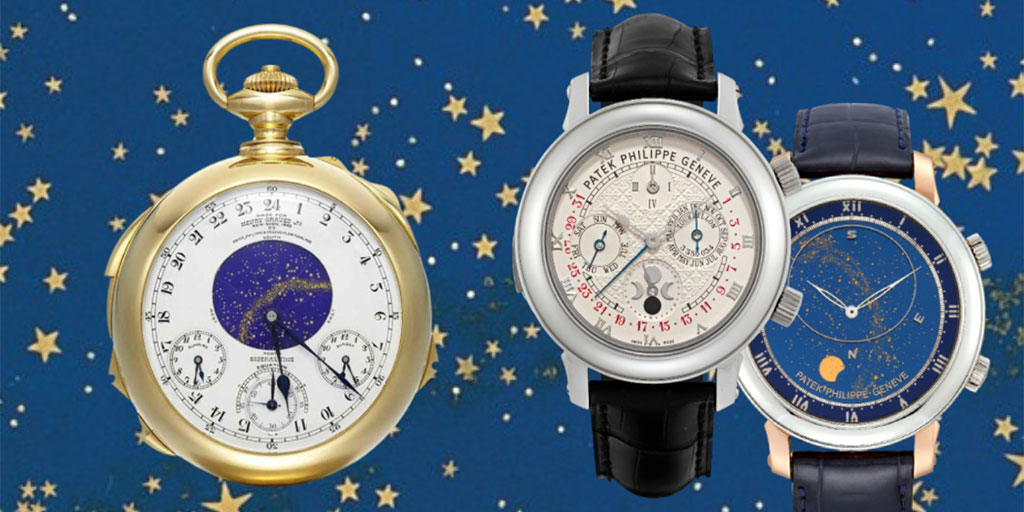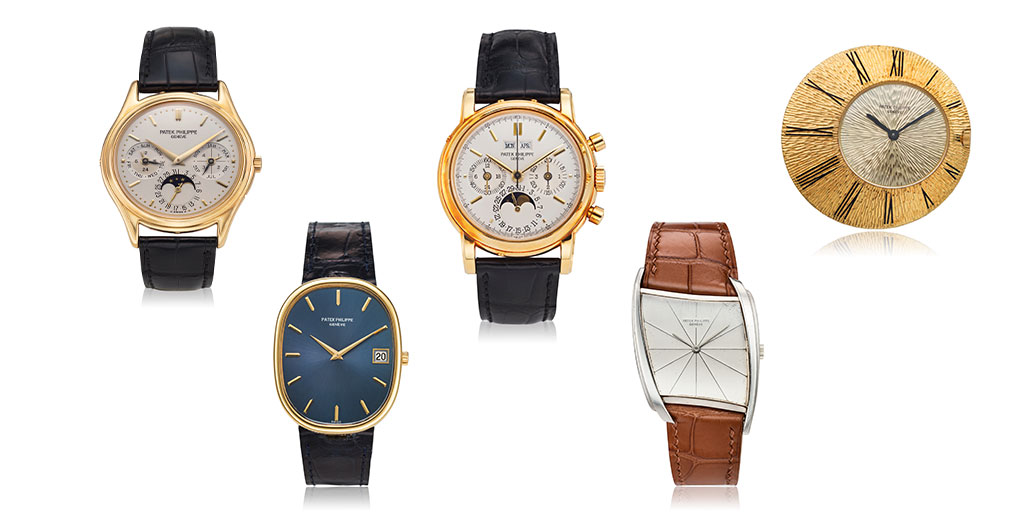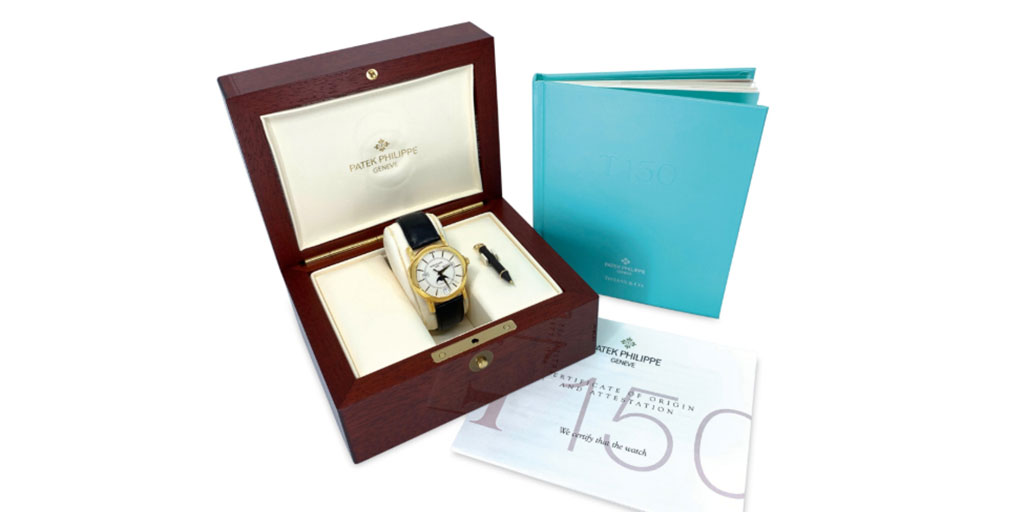In this second part of the history of one of Patek Philippe’s most fascinating retailer relationships, Carlos Torres explores the origin of the partnership with Paul Henrique Labouriau and the birth of Gondolo & Labouriau, the Chronometro Gondolo and how the infamous “Gondolo Gang” or “Clubs Patek Philippe” evolved.
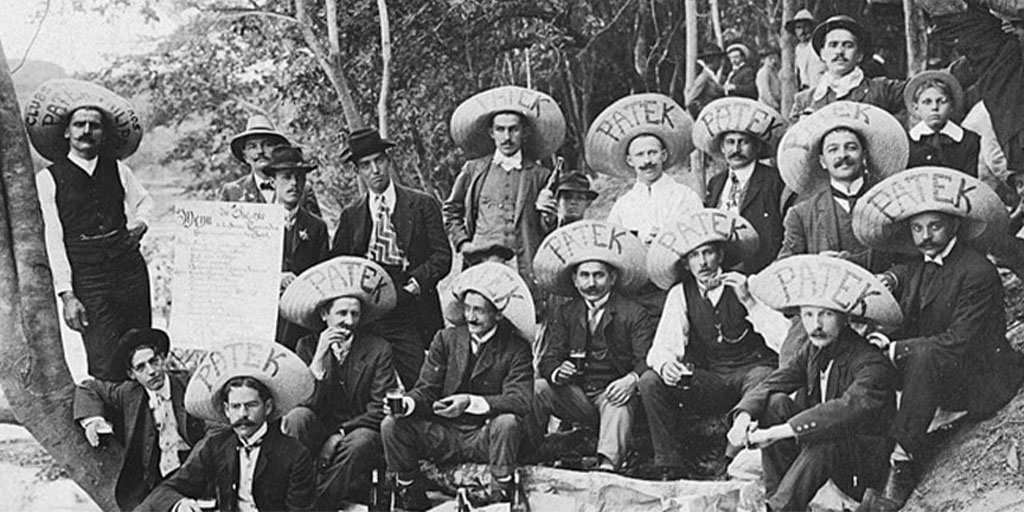
When Ferdinand Antoine Labouriau joined the jewelry business of Augusto Francisco Hyvernat together with Paulo Laforcade and registered it under the name of “Hyvernat e comp.” in 1863, his original diamond business at the 11, Rue Taitbout was already a renowned Parisian establishment. But the new business in Rio de Janeiro was to be managed “in absentia” since, at this time, the Labouriau family indicated their official address as being in Paris.
Augusto Hyvernat inherited the business from his father, François Hyvernat, who had settled in Rio in the early 1840s. The new partnership between Hyvernat and Labouriau was to remain at the same address on the busy street of 123, Rua dos Ourives. This was just one block away from Rua da Quitanda, where in 1871 Carlo Gondolo would open his first shop.

The family’s patriarch, Ferdinand Antoine Labouriau, may well have met Carlo Gondolo’s brother Emilio in Paris while he was working for Winnerl. The two addresses were just fifteen hundred meters from each other, and both attended the Vienna World Fair of 1873. Labouriau exhibited his diamond jewelry production, and Emilio, an exceptional and complicated pocket watch destined for the Emperor of Brazil. The Grand Sonnerie minute repeater with perpetual calendar and moon phase indication contributed to Emilio winning a First Class and Merit medal for his outstanding work.

By April 1875, Labouriau, Hyvernat and Laforcade took on an additional partner: Eugenio Brochard. The firm was adding watches to its selection of fine jewelry. It is not clear when Carlo Gondolo met the Labouriau family. But on September 13th, 1888, Ferdinand Antoine Labouriau and his wife were traveling from Le Havre to Rio de Janeiro on the same French steamer, the Ville de Buenos Ayres, as Carlo Gondolo. It is also undocumented if Carlo Gondolo’s daughter, Carlota Gondolo, met Antoine’s son, the then 24 years old Paul Labouriau, on that trip, but soon after, they were married.
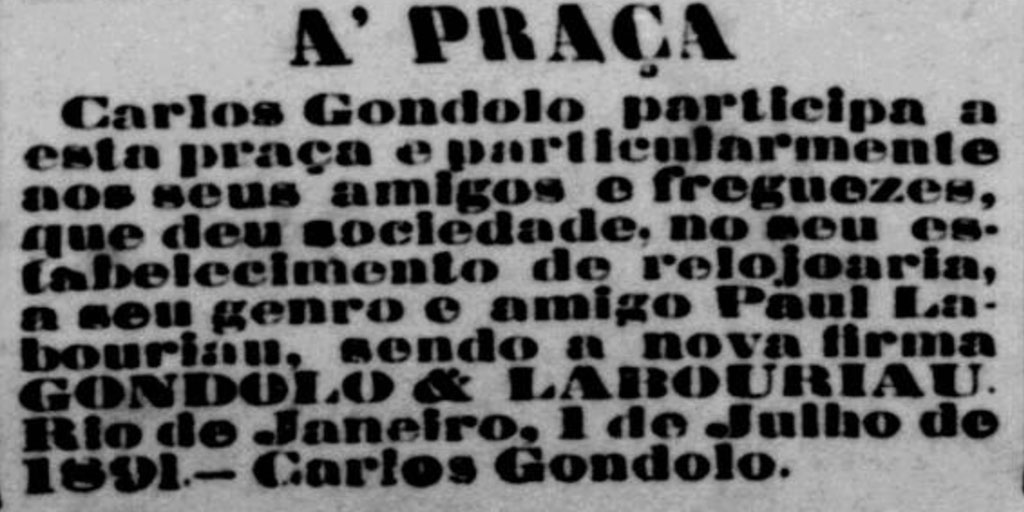
On July 1st, 1891, Carlo Gondolo let everybody know that he was giving full partnership to his friend and son-in-law Paul Henrique Labouriau. The firm would, from now on, take the name of Gondolo & Labouriau, changing the Brazilian horological scene forever and marking a unique period in the history of Patek Philippe.
The birth of Gondolo & Labouriau and the Chronometro Gondolo
The partnership between Carlo Gondolo and Paul Labouriau brought a new dynamic to the firm that took advantage of the strong, global economy that greatly influenced Brazil during this period in history.
Patek Philippe had established an early foothold in the country in 1849, but it took the Genevan watchmaker over four decades to officially register its name in Brazil. On August 21st, 1893, “Patek, Philippe & Co.” was formally added to the country’s book register of commercial brand names. At this time, communicating a watchmakers’ achievements on the stage of the World Fairs, and the results obtained on international chronometric competitions became of paramount importance to validate the top quality of the most capable watchmakers. Patek Philippe was well positioned in this race.

Patek Philippe started printing newspaper ads listing its achievements in various international competitions and exhibitions from 1881 onwards. Before the decade ended, that task was taken over by Carlo Gondolo, and later, Gondolo & Labouriau continued the tradition. The yearly Observatory competition results in which Patek Philippe usually excelled by collecting top prizes, brought another dimension to the manufacturer in the eyes of the elite public of Rio de Janeiro. Gondolo & Labouriau would even run full-page ads in the daily papers to better communicate the importance and prestige of these events.
The “Clubs Patek Philippe” – selling under a new concept
With the dawn of the new century, the world was enjoying a rare period of peace and prosperity. The new age promised incredible feats of humankind, and was considered a fertile ground for bright, innovative ideas and concepts.
Some merchants in Rio de Janeiro started to use a new selling technique that was gaining success in the USA, enabling sales to a broader audience. Known as the “Clubs”, the technique simplified the acquisition of expensive items by allowing payment by weekly installments. Upon completion of the weekly payments, without interest, the buyer would be able to claim his purchase.
Enthusiasm for the process was stimulated by a weekly draw that would reward one participant with ownership of the item. This way, the lucky “Club” member would have the chance to own the item without paying any further installments. This made great sense to Carlo Gondolo and Paul Labouriau, who knew that the system could substantially broaden the number of customers to whom they sold watches. The luxury of owning a gold cased pocket watch was about to become much more accessible, especially considering that the 740 franc cost of a watch was roughly the yearly salary of an average worker in Brazil at the time.
On December 10th, 1901, after just a few weeks of public announcement, the inaugural “Club Patek Philippe” started with all 180 participants fully signed up. The following Tuesday, December 17th, the first draw selected Mr. Luiz Maria Monteiro of 86, Rua da Luz, Rio de Janeiro, as the winner of a magnificent 22 lignes Patek Philippe gold cased pocket watch. He had just spent the small sum of 10 francs (8$000 rs) on the first installment and would be able to take the prized watch, valued at 740 francs, without any further expense. Registrations for the following 180 participants of the second “Club Patek Philippe” would open only two weeks later, on December 25th, also fully booked.

The watch Mr. Monteiro was so lucky to pick up just before Christmas that year was rather unique compared to the usual 22 lignes Patek Philippe pocket watches the Genevan maker produced for the rest of the world. Carlo Gondolo had decided that the watches offered through the “Club” system had to include additional, unique features to stand out from timepieces provided by other Patek Philippe retailers in Rio de Janeiro.
With this purpose in mind, he drew inspiration from the work of his late brother Emilio Gondolo. Emilio was very proud of a line of watches he had produced in which the wheel train was made of 9k gold instead of the usual brass. Carlo Gondolo requested that Patek Philippe add this feature, plus a straight-line “moustache” lever escapement, a cut bimetallic compensation balance with blued steel Breguet balance spring and a precise micro-metric cam-balance wheel regulator to the production of the movements exclusively for Gondolo & Labouriau.
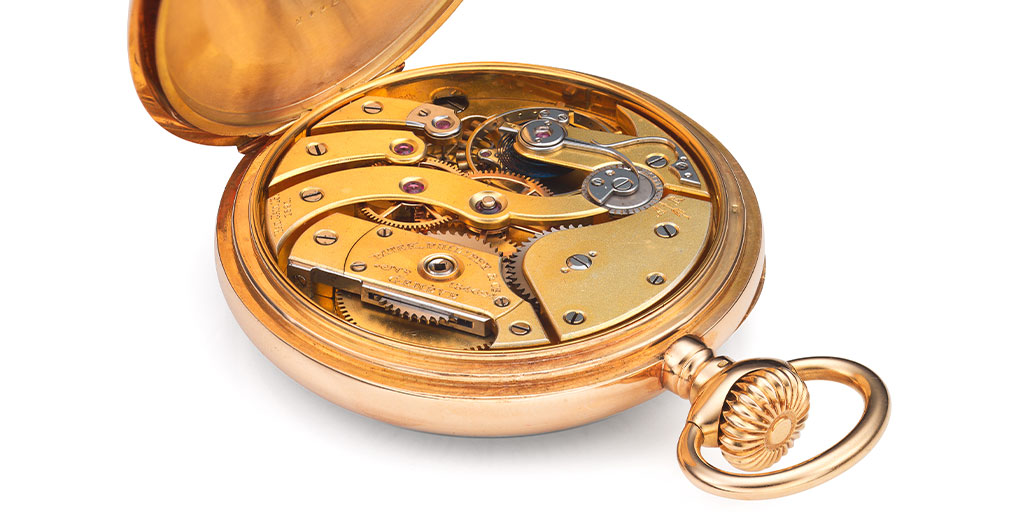
The polished 56 mm four-body case would be bassine shaped, with an engine-turned case-back adding a hinged gold cuvette—all with around 15 mm thickness and engraved with the inscription “Chronometro Gondolo – Fabricado expressamente para Gondolo & Labouriau Relojoeiros – Rio de Janeiro” (Made expressly for Gondolo & Labouriau Watchmakers – Rio de Janeiro).
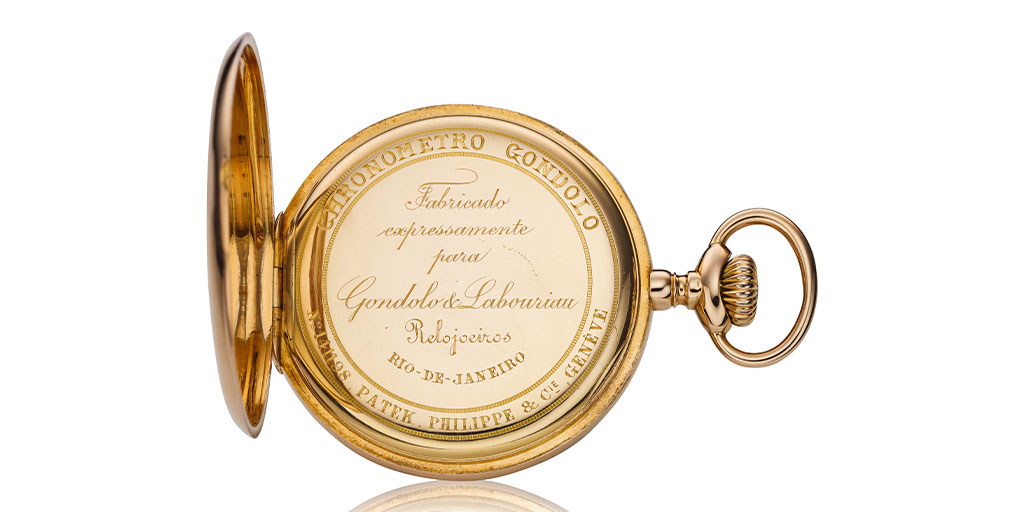
The name “Chronometro Gondolo” also appeared on the pristine, white enamel dial with radial Roman numerals, right above and around the sunk subsidiary seconds at six o’clock. Also made of gold, the spade hands would guarantee an unaltered appearance for decades to come.

By September 1901, before the start of the “Clubs”, Carlo Gondolo and Paul Labouriau had already secured three trademark registrations for the names “Gondolo”, “Chronometro Gondolo”, and “Clubs Patek Philippe” that were duly inscribed in the official books under numbers 1123, 1124 and 1125.
The rules for the whole endeavor were to be printed in the 1902 edition of the famous “Almanac of Laemmert”. The publication, a precursor to the modern yellow pages of Rio de Janeiro, had been published without interruption since 1843 and was an essential tool for every citizen in the city. Following its incredible initial success, the “Clubs Patek Philippe” would run continuously for the next thirty years, changing only with the number of participants.
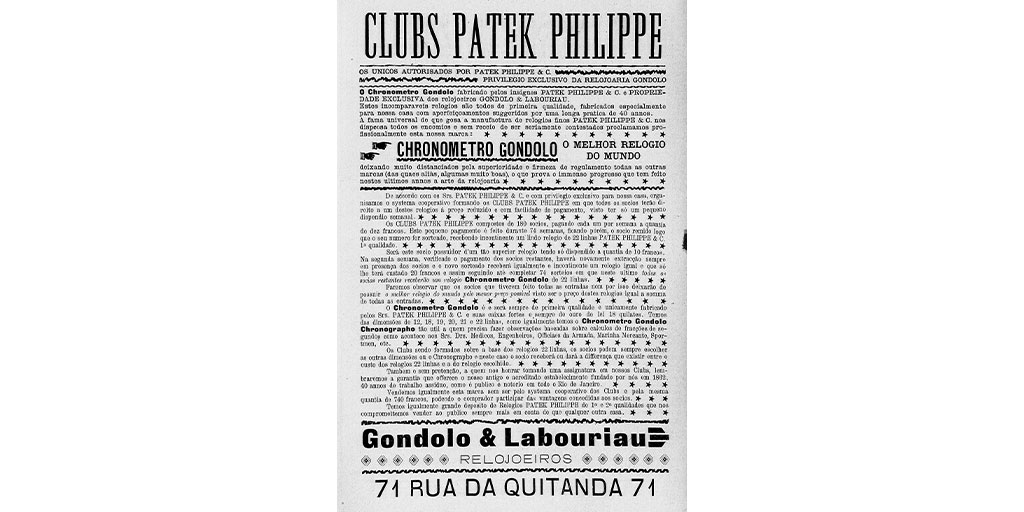
Between December 1901 and June 1915, Gondolo & Labouriau ran one hundred and eighteen “Chronometro Gondolo Clubs” with a duration of seventy-four weeks each. Until 1913, each one of these Clubs was made up of 180 participants, a number that, from 1914 onwards, briefly increased to 250 participants. The peak years were between 1904 and 1909, with sixteen “Clubs” running in 1906 alone.
In 1913, a new system was implemented with its weekly draws tied to the numbers published by the state lottery. Officially supervised by a designated government official, these highly popular Clubs congregated immense groups of a thousand participants each, surviving the ensuing First World War, until its very last edition in January 1931.
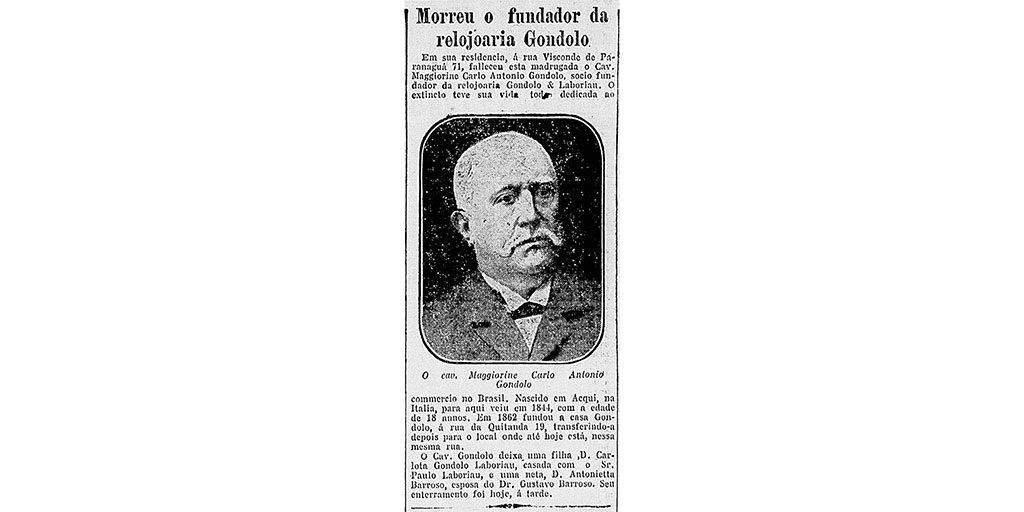
Cavaliere Maggiorine Carlo Antonio Gondolo died early on the morning of April 30th, 1919, at the age of 93. Born in Acqui, Piedmont, 45 km from Genoa in Italy, he had come to Rio aged just 18. The burial, leaving his beautiful mansion at 71, Rua Visconde de Paranaguá , took place on the same day.
With the death of Carlo Gondolo, the firm of Gondolo & Labouriau was dissolved on May 14th of that year and reinstated four months later by Paul Labouriau as “Gondolo, Labouriau & Decourt” with the share capital of 120,000$000 rs.
In the next and final installment of the history of Gondolo & Labouriau, we will learn about the circumstances that led to the downfall of the retailer and the repercussions this had on Patek Philippe.
Collectability would like to sincerely thank Carlos Torres for his relentless, in-depth research into the history of Gondolo & Labouriau. Over many months of investigative research, he has unearthed new academics on the history of the Brazilian retailer which have never been published before. Collectability is honored to exclusively publish his findings for the first time here.


